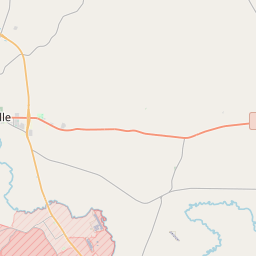Eagle Springs Baptist Church
Historical marker location:






This congregation grew from an early Coryell County fellowship known as the Church of Onion Creek. Worshippers met in a log building until it burned in 1854. In 1858 this site was acquired for a new church building. In the same year, the Rev. John McLain, a Baptist Missionary, organized the Eagle Springs Baptist Church from the earlier congregation. Charter members inclded J. H. and Nancy Estep; Evan A. and Tabitha Culpepper; Wyatt, Naomi and Serepha Hall; F. M. Elmira, and Mary Grimes; Daniel Jones; and C. S. and Zura Strickland.
By 1880 Eagle Springs was a thriving community with two grocery stores, two doctors' offices, a post office, and a school. The congregation grew also, with many baptisms being held in the Leon River.
During the first decades of the twentieth century, families began moving away form Eagle Springs. The community school was closed in 1935, and in 1948 members of Eagle Springs Baptist Curch voted to disband. The church building was retained, however, for reunions and occasional services. It is one of the few remaining structures in the Eagle Springs Community
As one of the most visible programs of the Texas Historical Commission (THC), historical markers commemorate diverse topics in Texas history, including: the history and architecture of houses, commercial and public buildings, religious congregations, and military sites; events that changed the course of local and state history; and individuals who have made lasting contributions to the state, community organizations, and businesses.
The first oil well in the United States was drilled in Texas in 1859. The discovery of oil transformed the economy of the state and helped to make Texas one of the wealthiest states in the nation.
During the Texas Revolution and the subsequent establishment of the Republic of Texas, Coryell County saw significant growth. The area attracted pioneers and settlers who were drawn by the fertile land along the rivers. In 1854, the county was officially organized and named after James Coryell, an early frontiersman who was known for exploring and surveying the area.
Throughout the late 19th and early 20th centuries, Coryell County experienced periods of prosperity and challenges. Agriculture, particularly cotton production, played a significant role in the local economy. The arrival of the railroad in the late 19th century enhanced the county's connectivity and spurred growth in trade and commerce.
The county also contributed to the military history of Texas. During World War II, Camp Hood (now Fort Hood) was established in the southern part of Coryell County. The military installation has had a profound impact on the local economy, serving as an economic engine and a significant employer for the region.
Today, Coryell County continues to thrive as a vibrant community. It is home to a diverse population and offers a mix of urban and rural landscapes. The county's rich history can be seen in its historic buildings, museums, and landmarks, all of which provide a glimpse into the past and contribute to the county's unique cultural identity.
Coryell County Timeline
This timeline provides a glimpse into the major events and milestones that have shaped the history of Coryell County, Texas.
- 1854 - Coryell County is established by the Texas legislature.
- 1859 - The county seat, Gatesville, is established.
- 1861-1865 - The American Civil War impacts Coryell County, leading to economic hardships.
- 1872 - The Texas Central Railroad is completed, boosting the county's economy.
- 1882 - The first county courthouse is constructed.
- 1905 - The original county courthouse is replaced with a new building.
- 1929 - The Coryell County Museum opens, showcasing the area's history.
- 1942-1946 - The county experiences growth during World War II due to the establishment of Camp Hood (now Fort Hood).
- 1963 - The current county courthouse is built, replacing the 1905 building.
- 1997 - The Coryell County Courthouse is added to the National Register of Historic Places.